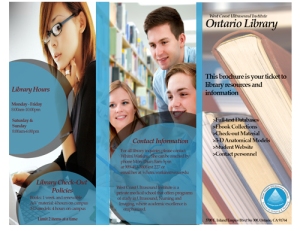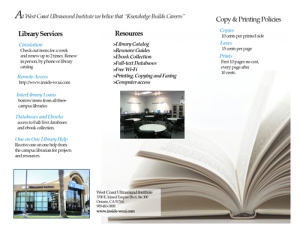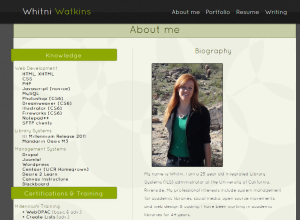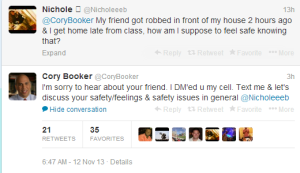SCCLD Social Media Internship Final Report
Whitni J. Watkins
San José State University, School of Library and Information Science
Abstract
The purpose of this report is to explain what I did and learned during my internship period with the Santa Clara County Library District (SCCLD) as their social media intern. The report is also a requirement for fulfillment of San Jose State University School of Library and Information Science’s Virtual Internship program. The report focuses primarily on the student learning outcomes (SLOs) and will include a breakdown of activities and tasks performed during the internship period and how they relate to the achievement of the SLOs.
Santa Clara County Library District
SCCLD consists of 7 community libraries, 1 branch library, 2 bookmobiles and an online library. They serve the areas of Santa Clara County in California including: Campbell, Cupertino, Gilroy, Los Altos, Lost Altos Hills, Milpitas, Monte Sereno, Morgan Hill, and Saratoga. They serve a population of 412,732 with a rate of 52% being current library cardholders.
As an intern with the Santa Clara County Library District (SCCLD), I was working with Megan Wong, the virtual library manager, to develop procedures and policies to help further the presence of the library in multiple social media platforms. SCCLD is present on 7 social media channels including: Facebook, Twitter, Instagram, Pinterest, LinkedIn, YouTube and 44 library blogs.
Internship selection
I chose to apply for this internship based upon my interest in the use of social media in organizations such as libraries. I also lacked professional experience in a public library, as all my experience is in academic libraries and SCCLD provided me both options.
Student Learning Outcomes
Prior to beginning my internship I worked with the internship supervisor, Megan Wong, and developed a set of SLOs that would outline the tasks and responsibilities to be accomplished during the internship period.
- Effectively identify, monitor and respond to the community audience formed around the library’s social media by reviewing previous posts and audience response on social media platforms (Facebook, & Twitter) and attending Reader’s Advisory meetings (virtually).
- Learn and practice best social media practices through hands on use of platforms including scheduling posts and daily interaction on forums to increase traffic on Santa Clara County Library district social media platforms; including Facebook, LinkedIn, and Twitter.
- Formulate a social media marketing plan; set up policies to manage a public social media account and the distribution of information.
Student Learning Outcomes
Learning Outcome 1.0
The first learning outcome was to effectively identify, monitor and respond to the community audience formed around the library’s social media by reviewing post and audience response on social media platforms, Facebook & Twitter and attend the reader’s advisory meetings virtually.
The first half of this learning outcome was achieved through daily monitoring of SCCLD’s Facebook page and Twitter account (See Appendix item 1 for clocked hours). Through my monitoring I learned what posts were most popular on Facebook, the time in which users frequented the page most often and as well as what posts reached the largest population (see Appendix item 2). The constant monitoring of Facebook allowed me opportunities to see what types of things the “fans” enjoyed seeing the most. This allowed me to recommend specific types of posts for staff to focus on to encourage more interaction on the page.
Monitoring the Twitter account was less insightful as the audience focus was less targeted, this became a recommendation item on the social media plan I put together. I used the opportunity while monitoring Twitter to find more community to follow, to communicate with those who tagged SCCLD in tweets. This received good feedback, one individual stated, “@sccld You’re awesome! Great job with the social media!” (See Appendix 3 for full conversation).
The second half of the SLO, attend Reader’s Advisory meetings, was later dropped by the internship supervisor due to scheduling constraints on both parties . Any information pertaining to my responsibilities as the intern was relayed to me by my supervisor.
Learning Outcome 2.0
The second learning outcome was to learn and practice best social media practices through hands on use of platforms, including scheduling posts and daily interaction on forums to increase traffic on SCCLD’s social media platforms; including Facebook & Twitter.
This SLO was achieved through research, daily interaction of SCCLD’s social media platforms and volunteering to post on the Facebook feed weekly. For research, refer to the bibliography page for a listing of articles that were used in shaping the focus and evolvement of SCCLD’s social media. Traffic for SCCLD has increased; the follower count for Twitter has grown by 29 followers since the beginning of the internship and Facebook has increased by almost 80 “likes”.
The biggest accomplishment SCCLD saw over the past 3 months was hitting the 1K milestone, 1,000 page likes on Facebook, without the use of a Facebook campaign. At the beginning of the internship period, SCCLD was looking at 927 likes by the end we were up to 1,006 likes (see appendix item 4). Through research and recommendations, the staff began posting content that sparked more interaction from our fans. The interaction provided greater opportunity for our Facebook page to be seen and receive more likes.
Another opportunity that came from monitoring Facebook daily was the opportunity to answer a reference question and turn it into a very positive experience. A patron made a comment on a post on Facebook and I responded to her comment, which then sparked this reference opportunity. This patron desired that a certain book be available on an audiobook service that SCCLD subscribes to. I found that although the service did not have the book, that the book was available on disc for checkout from the library. The patron was ecstatic about this revelation and left very happy. The interaction between myself and the patron is publically visible and created a positive experience that others can read and gain more insight to SCCLD.[1]
Learning Outcome 3.0
This SLO required that I take the knowledge I gained and formulate a social media plan and set up policies to manage a public social media account and the distribution of information.
The SLO was accomplished through 135 hours of research, hands on practice and incorporation of best practices. This was a difficult task to accomplish, as it required viewing each platform; see footnote for link to full social media plan.[2]
Along with the social media plan, Megan and I put together a best practices document that listed key bullet points for each platform about posting and things to keep in mind while managing the platform. For example, Twitter only allows 140 characters in posts, only use 120-130 of the characters so there is room for followers who want to retweet or quote your tweet. Another example is to always use the #SCCLD in Tweets and Instagram’s, this will help make SCCLD more searchable in the platforms.[3]
Conclusion
My internship experience with SCCLD was very positive. My supervisor exhibited a democratic management style where we each collaborated on ideas and together chose ones that fit the model we were working towards. This method of management was very effective as it allowed and encouraged innovation. I would recommend that there be more insight from the managing side to help better guide the focus of the organization. This would have been more helpful because I was an outsider to the organization.
Code of Ethics: ALA
One thing I found was that SCCLD was very strict into adhering to statement II of the ALA Code of Ethics that reads, “We uphold the principles of intellectual freedom and resist all efforts to censor library resources.” One example of this was a user posted a quote on the SCCLD Facebook page that contained the F word. The user did not censor the word in the quote; however SCCLD policies enforce that staff does not censor comments made on public platforms as it is a violation of patron’s right of speech. Although my instinct said to “hide” the comment as to not offend those who read the post, I knew that the policy was not only enforced but was also in accordance with the ALA Code of Ethics by which I, as a current ALA member, established I would do my best to uphold.
Responsibilities
While working with SCCLD my primary responsibilities included:
- Build followers on Facebook, work towards gaining better awareness
- Develop best practices for Facebook, Twitter, & Instagram
- Monitor and participate in Facebook & Twitter posting
- Develop procedures for implementing an Instagram photo contest
- Develop procedures for implementing a Facebook campaign
My main priorities were developing the procedures for different platforms and researching best practices. My site supervisor broke down each month’s priorities based upon what was accomplished and learned in the prior month. One action item that stayed continuously on the menu was finding a way to gain better awareness on Instagram and to use it to promote the library. The action plan was of great help to keep priorities in view; and I recommend that it be a best practice for future SCCLD internships.
The most difficult aspects of working in this [virtual] environment was connecting with the library. Due to schedule constraints I did not get the opportunity to participate in the Reader Advisory meetings and in part I felt like this created a gap between me and the staff. I wish the staff would have reached out to me more to give feedback or insight on how they are currently using social media; however I could have encouraged this more by sending out emails and interacting with them more. I think this was a difficulty primarily because this was a virtual internship and had I been on site my interaction with staff would have been satisfactory.
Technology
Throughout the internship I used a variety of technology to accomplish the tasks set before me. I used email, Google Docs, and the Virtual Library Wiki for collaboration with my site supervisor as well as some staff at SCCLD. I used social media platform mobile applications for iOS[4] to manage SCCLD’s accounts including; Twitter, Facebook, Pages, Cubenect, SCCLD mobile site app, WordPress, and Instagram. I also used the full website pages for Twitter, Facebook, WordPress & sccl.org to manage these same accounts. All tasks were easily accomplished through these forms of technology and I do not have any recommendations for improvement.
Course Work
As I made my way through this internship program I found myself grateful that I had taken Libr246: Social Media & Web 2.0 tools. This course, although only briefly, provided me with an overview of how some libraries used social media. It also introduced me to some of these libraries that had great examples, such as NYPL, to refer to during my research. I also found myself referring back to information I learned in Libr210: Reference and Information services, specifically Reader’s Advisory services. The reader’s advisory will be incorporated through Facebook posts, Pinterest boards and library blogs. These ideas were introduced to me through Libr210. Although I have a strong background in social media, these two courses introduced me to aspects of the library that I may have over looked during my research, specifically the use of Pinterest in the library.
Equally, I would have been better equipped had I taken course work on censorship and public libraries. This internship was my first non-patron experience in a public library, so many rules that exist in a private academic library in regards to censorship are forbidden in many public libraries. I am a firm believer in not censoring however it is still an area I do not know much about. I also think course work in library marketing would have helped me in the long run as a put together the social media plan. I am confident in my work but I know that having a formal foundation in library marketing would have saved me time as I set up action items for the social media plan.
I feel that this internship exposed me to opportunities and experiences that helped me more fully understand the impact social media can have on organizations. Although the work I performed during this period seemed insignificant in process, when put into the bigger picture I realize that this helped structure SCCLD’s social media presence. The social media plan will be a basis from which SCCLD can build their policies and procedures; this is of significant value to the organization.
Working with SCCLD has helped me form a more professional view of social media and how I can now use it to my advantage in advancing my career. I have a solid understanding of Facebook, as well as the ability to create and implement Facebook campaigns for other organizations with which I may work. I can state that my internship at SCCLD was a rewarding experience and I will take from it a significant amount of primary evidence as well as a new perspective on using social media in libraries.
References
American Library Association. (2008). Code of Ethics of the American Library Association. Retrieved from http://www.ala.org/advocacy/proethics/codeofethics/codeethics
Santa Clara County Library District. (2013). Social Media Policy [PDF]. Retrieved from Santa Clary County Library District Staff Wiki (private access).
Watkins, W. (2013, October 27). Facebook: the form of reference/advertising/reader’s advisory AIO [Web log post]. Retrieved from https://nimblelibrarian.wordpress.com/2013/10/27/facebook-the-form-of-referenceadvertisingreaders-advisory-aio/
[1] Encounter recap provided from full blog post: https://nimblelibrarian.wordpress.com/2013/10/27/facebook-the-form-of-referenceadvertisingreaders-advisory-aio/
[2] Full social media plan, drafted and submitted by Whitni Watkins to SCCLD: http://bit.ly/1e2eNnE
[3] Best Practices guidelines document: http://bit.ly/18y5MOx
[4] The use of mobile applications was not a requirement to accomplish my responsibilities; their use merely provided convenience and all tasks could be accomplished through the web browser.














